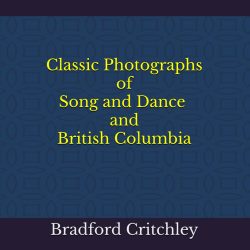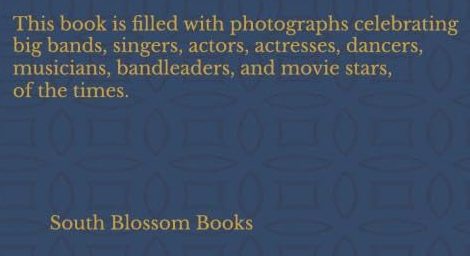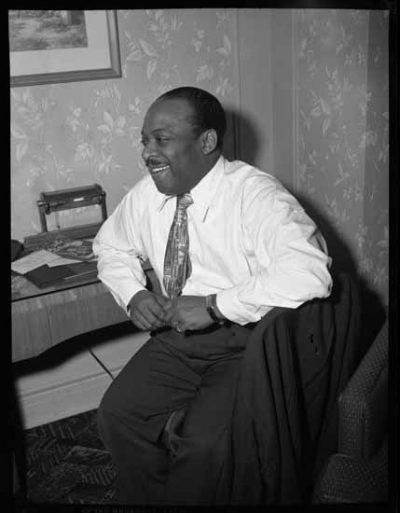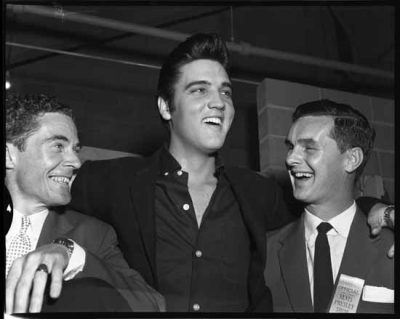Historical ‘visual feast of images’
Classic Photographs of Song and Dance and British Columbia
by Bradford Critchley
Vancouver: South Blossom Books, 2024
$18.49 / 9798326042392
Reviewed by Wayne Norton
*

Cyberpunk author William Gibson once noted that historical writing is just a form of speculative fiction. Historians can readily agree with Gibson that changing attitudes and perceptions always influence their writing, but they will not likely enjoy his characterisation of their efforts. Yet, everyone accepts that biographical treatments of the icons of popular culture often do more than simply flirt with speculative fiction. Some are fully immersed in it. Layers of fiction and rumour readily seem to attach to performers of stage, screen, or sound, be they celebrities only locally known or globally recognised icons. Readers of biographies and magazine articles and viewers of biopics and documentaries need to tread carefully if historical accuracy—facts and context, rather than fiction and fluff—is what they seek.

Bradford Critchley’s new book, Classic Photographs of Song and Dance and British Columbia, therefore, presents something of a dilemma for readers who appreciate facts and context. Critchley provides none. He presents 187 photographs—most, but not all, taken in Vancouver between 1900 and 2014—with only the name of the subject, the date taken and the provenance. The lack of information for each image requires readers like me to search our memories for some context. I happen to be a lazy reader. I like to have information provided, even if it only because I can then question it. How do photographs of Sammy Davis Jr in Toronto and Nina Simone at the Newport Jazz Festival on Rhode Island qualify as classic images from British Columbia? Who are all these notable Vancouver musicians? Tell me about the connections, please!

The absence of further information is both liberating and frustrating at the same time. On the liberating side of that coin, it is a pleasure to flip through the book wondering what the next page will bring. The purely visual experience allows me to focus on personal familiar favourites, unburdened by any knowledge or misconceptions (apart from my own). There’s a smiling Count Basie in Vancouver in 1951. It was a discouraging time for Basie. In step with many others, his big orchestra was disbanded and newer trends like bebop held little appeal for him. I wonder if he was in Vancouver just as a tourist or if he was performing somewhere with a small group. My mind automatically goes to his wonderful reformed big band of the mid-1950s and their “April in Paris.”
There is Paul Robeson, smiling for the camera in front of a microphone for CJVI radio station in Victoria in 1956. I didn’t know Robeson had been in Victoria in 1956 and again I wonder if he was performing somewhere or if the occasion was only an on-air interview. A curtain provides the backdrop to the photograph, which suggests a performance broadcast by CJVI. He drew huge crowds for his series of Peace Arch concerts at Blaine when the American government denied him a passport in the early 1950s, but his failing health meant he had to cancel another concert planned there in 1956. Perhaps he just dashed over to Victoria instead!

If it is difficult to agree that all the photographs included in the book are truly classic, the three of Elvis Presley found at the Vancouver Public Library certainly are. From images captured at Empire Stadium in 1957, Presley’s face just leaps from the page. Anyone searching for the meaning of natural star power need only look at these photographs to see someone who genuinely possessed it. There are many other images of international stars of screen, stage, and vinyl, but none match that Presley visual magic.
When all is said and done, it may well be the images of local artists—not the likes of Robeson, Basie, and Presley—and local venues—the Grandview Theatre of 1921, the Kamloops Theatre of 1930, the capitol Theatre of 1943—that will appeal most to readers. From Juliette and Fraser McPherson and Mart Kenney to Stan “Cuddles” Johnson and Oliver Gagnon and Dave Pepper; from the Spanish Grill at the Hotel Vancouver, the Ambassador Café and the Arctic Club to the Cave, Critchley provides a visual feast of images. Readers can attach their own layers of facts and context, of fictions and personal memories. From that perspective, browsing through this impressive collection of memorable photographs will provide satisfaction and pleasure to anyone interested in the history of song and dance in British Columbia.
*

Wayne Norton is a writer, publisher, and historical consultant. For many years he was a teacher in Fort Rupert, Kamloops, and England. He has written extensively on a variety of topics including music of the First World War, the history of women’s ice hockey, prairie settlement, public health, and the local histories of Kamloops and Fernie. He was a research consultant for the Indian Residential School Process and has published articles in The Ormsby Review, British Columbia History, BC Studies, The Globe and Mail, and The Vancouver Sun. He is the author of two Caitlin Press titles, Beneath the Coal Dust (2022) and Fernie at War (2017), and has received the Community History award from the British Columbia Historical Federation. Wayne lives in Victoria. [Editor’s Note: Wayne Norton has reviewed books by Jon Bartlett, the late Ron Hatch, and Alan Livingstone MacLeod for The British Columbia Review, and has also contributed an essay: Refuge of a Scoundrel: Patriotism and William Bowser.]
*
The British Columbia Review
Interim Editors, 2023-26: Trevor Marc Hughes (non-fiction), Brett Josef Grubisic (fiction)
Publisher: Richard Mackie
Formerly The Ormsby Review, The British Columbia Review is an on-line book review and journal service for BC writers and readers. The Advisory Board now consists of Jean Barman, Wade Davis, Robin Fisher, Barry Gough, Hugh Johnston, Kathy Mezei, Patricia Roy, and Graeme Wynn. Provincial Government Patron (since September 2018): Creative BC. Honorary Patron: Yosef Wosk. Scholarly Patron: SFU Graduate Liberal Studies. The British Columbia Review was founded in 2016 by Richard Mackie and Alan Twigg.
“Only connect.” – E.M. Forster